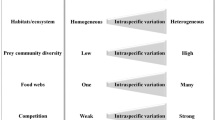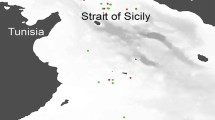Abstract
Ontogenetic variations in shark diet are often qualitatively inferred from dietary analysis and hindered by high levels of unidentified prey or small sample sizes. This study focused on nursery bound lemon sharks (Negaprion brevirostris, n = 396), enabling some control over the confounding variables of prey choice associated with ontogeny. Nursery bound lemon sharks exhibited weak ontogenetic variation in dietary composition with high levels of dietary overlap. Variation in prey preference of lemon sharks with ontogeny was complex, but revealed a continuous shift from predominantly opportunistic benthic foraging as neonates to more selective piscivory with increasing shark size while in the nursery. Lemon sharks demonstrated a discrete ontogenetic shift in the number of prey consumed and stomach content weight (Kruskal-Wallis tests p < 0.01), as well as prey size (ANOVA, p < 0.001). All sizes of sharks exhibited positive size selection of prey (Mann–Whitney U tests, p < 0.01). However, the lack of size preference by all but the largest lemon sharks for their major prey (yellowfin mojarra, Gerres cinereus), suggests neonate sharks, while capable of occasionally foraging on large prey, are relatively inept opportunistic foragers. This was evident in high diet breadth, low diversity of consumed prey and lower trophic level than larger sharks. This study represents the first quantitative analysis of ontogenetic variation in prey preference and size selection in sharks, indicating a flexible foraging tactic in lemon sharks and the importance of hunting ability and predator size in prey choice.



Similar content being viewed by others
References
Barker MJ, Gruber SH, Newman SP, Schluessel V (2005) Spatial and temporal variation in growth of nursery bound juvenile lemon sharks (Negaprion brevirostris), a comparison of two novel age-assigning techniques. Environ Biol Fish 72:343–355
Beamish FWH (1978) Swimming capacity. In: Hoar WS, Randall DJ (eds) Fish physiology. Academic, New York, pp 101–187
Bethea DM, Buckel JA, Carlson JK (2004) Foraging ecology of the early life stages of four sympatric shark species. Mar Ecol Prog Ser 268:245–264
Bethea DM, Carlson JK, Buckel JA, Satterwhite M (2006) Ontogenetic and site-related trends in the diet of the Atlantic Sharpnose shark Rhizopriondon terraenovae from the Northeast Gulf Mexico. Bull Mar Sci 78:287–307
Beulig A (1982) Social and experimental factors in the responsiveness of sharks to sound. Fla Sci 45:2–10
Christensen B (1996) Predator foraging capabilities and prey antipredator behaviours: pre- versus postcapture constraints on size-dependent predator-prey interactions. Oikos 76:368–380
Cortés E (1997) A critical review of methods of studying fish feeding based on analysis of stomach contents: application to elasmobranch fishes. Can J Fish Aquat Sci 54:726–738
Cortés E (1999) Standardized diet compositions and trophic levels of sharks. ICES J Mar Sci 56:707–717
Cortés E, Gruber SH (1990) Diet, feeding habits and estimates of daily ration of young lemon sharks, Negaprion brevirostris. Copeia 1990:204–218
Cortés E, Manire CA, Hueter RE (1996) Diet, feeding habits, and diel feeding chronology of the bonnethead shark, Sphyrna tiburo, in southwest Florida. Bull Mar Sci 58:353–367
Ellis JK, Musick JA (2007) Ontogenetic change in the diet of the sandbar shark, Carcharhinus plumbeus, in lower Chesapeake Bay and Virginia (USA) coastal waters. Environ Biol Fish 80:51–67
Gotelli NJ, Entsminger GL (2009) EcoSim: null models software for ecology. Version 7. Acquired Intelligence Inc. and Kesey-Bear. Jericho, VT 05465. http://garyentsminger.com/ecosim.htm
Gruber SH, de Marignac JR, Hoenig JM (2001) Survival of juvenile lemon sharks (Negaprion brevirostris) at Bimini, Bahamas, estimated by mark-depletion experiments. T Am Fish Soc 130:376–384
Heithaus MR (2004) Predator-prey interactions. In: Carrier JC, Musick JA, Heithaus MR (eds) Biology of sharks and their relatives. CRC, Boca Raton, pp 487–521
Johnson DH (1980) The comparison of usage and availability measurements for evaluating resources preference. Ecology 61:65–71
Juanes F (1994) What determines prey size selectivity in piscivorous fishes? In: Strouder DJ, Fresh KL, Feller RJ (eds) Theory and application in fish feeding ecology. S Carolina University Press, Columbia, pp 79–100
Juanes F, Buckel JA, Scharf FS (2001) Predatory behaviour and selectivity of a primary piscivore: comparison of fish and non-fish prey. Mar Ecol Prog Ser 217:157–165
Koen-Alonso M, Crespo EA, García NA, Pedraza SN, Mariotti PA, Mora NJ (2002) Fishery and ontogenetic driven changes in the diet of the spiny dogfish, Squalus acanthias, in Patagonian waters, Argentina. Environ Biol Fish 63:193–202
Krebs CJ (1999) Ecological methodology 2nd ed. Benjamin Cummings California
Lowe CG, Wetherbee BM, Crow GL, Tester AL (1996) Ontogenetic dietary shifts and feeding behaviour of the tiger shark, Galeocerdo cuvier, in Hawaiian waters. Environ Biol Fish 47:203–211
Lucifora LO, García VB, Menni RC, Escalante AH (2006) Food habits, selectivity, and foraging modes of the school shark Galeorhinus galeus. Mar Ecol Prog Ser 315:250–270
Lucifora LO, García VB, Menni RC, Escalante AH, Hozbor NM (2009) Effects of body size, age and maturity stage on diet in a large shark: ecological and applied implications. Ecol Res 24:109–118
Manire CA, Gruber SH (1993) A preliminary estimate of natural mortality of age-0 lemon sharks, Negaprion brevirostris. NOAA Technical Report. NMFS 115:65–72
McElroy WD, Wetherbee BM, Mostello CS, Lowe CG, Crow GL, Wass RC (2006) Food habits and ontogenetic changes in the diet of the sandbar shark, Carcharhinus plumbeus, in Hawaii. Environ Biol Fish 76:81–92
Morrissey JF, Gruber SH (1993) Home range of juvenile lemon sharks, Negaprion brevirostris. Copeia 1993:425–434
Newman RM, Waters TF (1984) Size-selective predation on Gammarus pseudolimnaeus by trout and sculpins. Ecology 65:1535–1545
Newman SP, Handy RD, Gruber SH (2007) Spatial and temporal variations in mangrove and seagrass faunal communities at Bimini, Bahamas. Bull Mar Sci 80:529–553
Newman SP, Handy RD, Gruber SH (2010) Diet and prey preference of juvenile lemon sharks, Negaprion brevirostris. Mar Ecol Prog Ser 398:221–234
Pinkas LM, Oliphant S, Iverson ILK (1971) Food habits of albacore, bluefin tuna, and bonito in Californian waters. Calif Fish Game 152:1–105
Roff DA (1992) The evolution of life histories: theory and analysis. Chapman and Hall, New York
Ross ST (1986) Resource partitioning in fish assemblages: a review of field studies. Copeia 1986:352–388
Salini JP, Blaber SJM, Brewer DT (1992) Diets of sharks from estuaries and adjacent waters of the North-eastern Gulf of Carpentaria, Australia. Aust J Mar Freshwater Res 43:87–96
Scharf FS, Juanes F, Roundtree RA (2000) Predator size – prey size relationships of marine fish predators: interspecific variation and effects of ontogeny and body size on trophic-niche breadth. Mar Ecol Prog Ser 208:229–248
Schmidt TW (1986) Food of young juvenile lemon sharks, Negaprion brevirostris (Poey), near Sandy Key, Western Florida Bay. Fla Sci 49:7–10
Schmitt RJ, Holbrook SJ (1984) Ontogeny of prey selection by black surfperch Embriotica jacksonii (Pisces: Embiotocidae): the roles of fish morphology, foraging behaviour and patch selection. Mar Ecol Prog Ser 18:225–239
Schurdak ME, Gruber SH (1989) Gastric evacuation of the lemon shark, Negaprion brevirostris (Poey) under controlled conditions. Exp Biol 48:77–82
Simpfendorfer CA, Goodreid AB, McAuley RB (2001) Size, sex and geographic variation in the diet of the tiger shark, Galeocerdo cuvier, from Western Australian waters. Environ Biol Fish 61:37–46
Springer S (1950) Natural history notes on the lemon shark, Negaprion brevirostris. Tex J Sci 3:349–357
Stearns SC (1992) The evolution of life histories. Oxford University Press, Oxford, p 264
Stevens JD, Bonfil R, Dulvy NK, Walker PA (2000) The effects of fishing on sharks, rays, and chimeras (chondrichthyans), and the implications for marine ecosystems. ICES J Mar Sci 57:476–494
Werner EE, Gilliam JF (1984) The ontogenetic niche and species interactions in size-structured populations. Ann Rev Ecolog Syst 15:393–425
Wetherbee BM, Cortés E (2004) Food consumption and feeding habits. In: Carrier JC, Musick JA, Heithaus MR (eds) Biology of sharks and their relatives. CRC Press LLC, Florida, pp 225–246
Wetherbee BM, Gruber SH, Cortés E (1990) Diet, feeding habits, digestion and consumption in sharks, with special reference to the lemon shark, Negaprion brevirostris. In: Pratt jr HL, Gruber SH, Tauriuchi T (eds) Elasmobranchs as living resources, advances in the biology, ecology, systematics and the states of the fisheries. NOAA technical report, RSMAS, pp 29–47
Winemiller KO (1989) Ontogenetic diet shifts and resource partitioning among piscivorous fishes in the Venezuelan Ilanos. Environ Biol Fisches 26:177–199
Winemiller KO, Pianka ER (1990) Organization and natural assemblages of desert lizards and tropical fishes. Ecol Monogr 60:27–55
Acknowledgements
This study was supported in part by a studentship from the University of Plymouth (SPN), the Florida Department of Education (Grant 874-97030-00001, SHG), PADI project AWARE (SPN), and Bimini Biological Field Station and its supporters. We thank R. Mann and L. Hoover, The Greentweed Foundation, the Hoover Foundation, T. and T. Fujino, B. & T. Newman, N. and E. Phillips, S. and T. Daniels, and R. Rosenberg for generous private support. This work was carried out in collaboration with the Bimini Biological Field Station, Bahamas, under University of Miami’s Bahamian research permit (MAF/LIA/22). We acknowledge the key role of the Bimini Biological Field Station staff and volunteers for assistance with data collection, with special thanks to K. Parsons, D. McElroy, C. Hofmann. We gratefully acknowledge the support of the people of Bimini, and the Commonwealth of the Bahamas for allowing us to work in the controlled waters of the Bahamas. Ethical approval and permissions were in place for all procedures in accordance with the current laws of the Bahamas.
Author information
Authors and Affiliations
Corresponding author
Rights and permissions
About this article
Cite this article
Newman, S.P., Handy, R.D. & Gruber, S.H. Ontogenetic diet shifts and prey selection in nursery bound lemon sharks, Negaprion brevirostris, indicate a flexible foraging tactic. Environ Biol Fish 95, 115–126 (2012). https://doi.org/10.1007/s10641-011-9828-9
Received:
Accepted:
Published:
Issue Date:
DOI: https://doi.org/10.1007/s10641-011-9828-9




